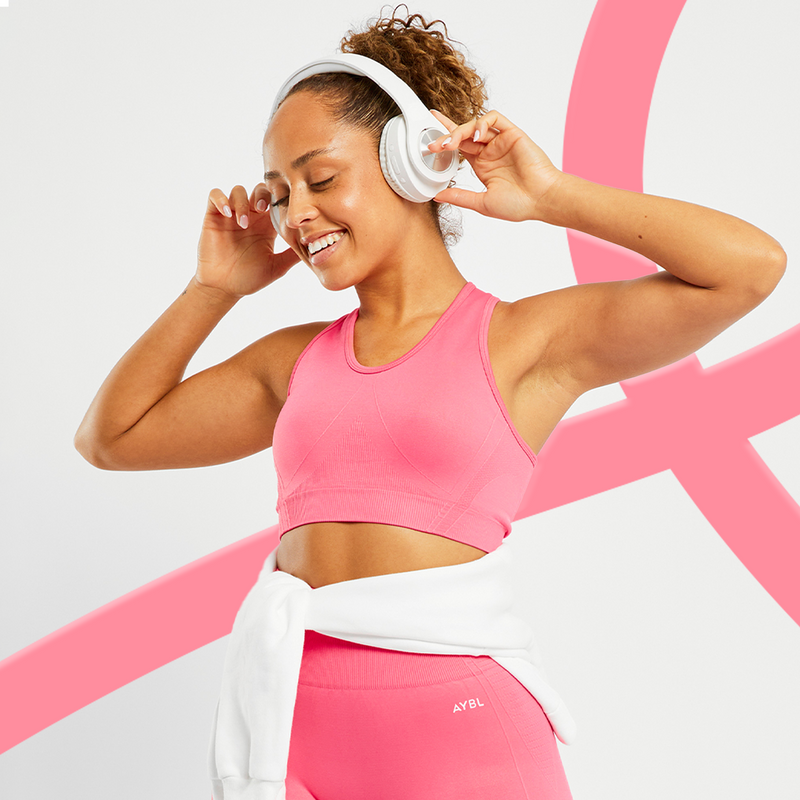
Breast Cancer Awareness Month: How To Check Your Breasts
Boobs, breasts, knockers, melons… Whatever you call them, there’s no denying that our boobs have been with us through a lot.
We’re talking about everything from those weekly HIIT sessions to those spontaneous speedy ascents (and descents) of the stairs. If you know, you know.
And while we’re big advocates of finding the right support for your breasts, the biggest challenge we face is in fact knowing how to check our breasts.
Granted, it may seem a bit daunting at first, but breast health is a conversation that shouldn’t be taken lightly.
According to Cancer Research UK, there are almost 56,000 new cases of breast cancer in the UK every year. Breast cancer can affect both men and women and at any point in their lives, which is why checking regularly is so important.
Like many forms of cancer, early detection is key, and spotting it early increases your chances of survival. That’s why this Breast Cancer Awareness Month, we’re taking you through how to check your breasts properly, what to look for and how to spot anything unusual.
WHAT SHOULD YOU BE LOOKING FOR?
While a lump is usually the first noticeable symptom of breast cancer - and actually most breast lumps are not cancerous - there are several other indicators you should be keeping an eye out for too.
If you notice one or more of these symptoms, it’s really important that you see a GP as soon as possible.
- A change in the size or shape of one or both breasts;
- A lump or swelling in either of your armpits;
- Puckering or dimpling on the skin of your breasts;
- A rash on or around your nipple;
- A change in the appearance of your nipple, such as nipple inversion and changes in direction;
- Discharge from either of your nipples.

HOW OFTEN SHOULD YOU CHECK YOUR BREASTS?
It’s recommended to check your breasts once a month. To make sure you never forget, it’s a good idea to set a regular date for checking, like the first of every month.
If you have periods, try to check a few days after your menstrual cycle, as it's likely that your boobs will naturally change as part of your cycle.
Self-examinations help you to become familiar with the normal look and feel of your own boobs and can empower you to detect changes that warrant checking in with a health care provider.
HOW TO CHECK YOUR BREASTS
1. GET COMFORTABLE
We know checking your breasts can be scary, so it’s important to get yourself comfortable and relax.
Whether you’re standing up or lying down, in the shower or in bed, you can do it whichever way suits you. In fact, it’s actually a good idea to check both standing up and lying down.
Remember to check regularly! Popping a reminder in your phone can help.
2. TAKE A CLOSE LOOK
Many of the signs and symptoms of breast cancer are changes you would only notice by looking at the appearance of your boobs.
Using a mirror, make sure to closely examine everywhere you have breast tissue. This includes across and beneath your boobs, all the way up to your collarbone and underneath your armpits. This is the same for all genders.
Do this with both your arms raised and then with them down by your side. Remember you’re looking for any skin or size changes, or any swelling or obvious lumps.
3. GET A GOOD FEEL
Using a flat palm or your fingertips, apply a light-to-medium amount of pressure and work your way around the whole of each breast, as well as all the other key areas mentioned above too.
It may help to use soapy or oily hands, which is why some women prefer to check in the shower, but always do what makes you feel comfortable.
As you feel, be mindful of any irregularities, such as lumps and thickening, changes in size or shape, or any skin changes.

WHAT SHOULD I DO IF SOMETHING DOESN’T FEEL RIGHT?
First things first, don’t panic! We know it’s easier said than done, but most breast lumps are actually non-cancerous.
That being said, if anything doesn’t feel right or you notice any changes, get in touch with your GP as soon as possible, as your doctor is the only person who can refer you for further examination.
Checking your breasts regularly is one of the most efficient ways to detect breast cancer early on and it’s early detection that can help save lives. Don’t forget to make a monthly habit of it!
For more information on all things breast health, there are a number of charities and non-for-profit organisations, including CoppaFeel!, Breast Cancer Now and Breastcancer.org, who have a huge amount of valuable resources.
It’s time to get checkin’!